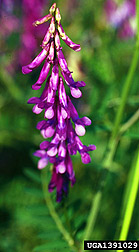Washington, DC
November 14, 2008
Agricultural Research Service, USDA
By
Dennis O'Brien
 |
|
ARS
has licensed two hardier and earlier flowering varieties
of hairy vetch, a common cover crop for farmers that
holds in moisture, prevents weed growth, curbs erosion
and reduces the need for nitrogen fertilizer. Photo
courtesy of John D. Byrd, Mississippi State University,
Bugwood.org. |
The
Agricultural Research Service
(ARS) has entered into licensing agreements with four seed
distributors interested in marketing varieties of a new hairy
vetch developed by an ARS scientist and cooperators.
Hairy vetch is a common cover
crop planted in the fall that lies dormant throughout the winter
and flowers in the spring. It can be tilled into the soil or
rolled onto the soil surface, leaving a mat of protective stems
that hold in moisture, prevent weed growth and curb erosion.
The two new varieties, Purple
Bounty and Purple Prosperity, were developed by geneticist
Tom Devine with the
ARS Sustainable Agricultural Systems Laboratory in
Beltsville, Md., and cooperators. The two new hairy vetches are
hardier and flower earlier than traditional varieties, adding up
to two weeks to the growing season for corn, tomato, pumpkin and
other summer crops.
ARS has licensed Purple
Prosperity to Ted Weydert of DeKalb, Ill., and has licensed both
Purple Prosperity and Purple Bounty to the
Albert Lea Seed Co. of
Albert Lea, Minn., Kings AgriSeeds LLC of Ronks, Pa., and
Allied Seed LLC of
Nampa, Idaho.
Organic farmers have been using
hairy vetch for decades because it adds nitrogen to the soil
without the use of synthetic or manufactured fertilizers. But
previous earlier flowering varieties had limited use north of
Maryland because they cope poorly with northern winters. The new
varieties allow farmers to grow earlier-flowering vetch as far
north as Ithaca, N.Y. The plants, named for their striking
purple blooms, may also be attractive to conventional farmers
because they cut in half the need for synthetic fertilizers,
which are made using expensive natural gas.
Devine spent the past decade
breeding the varieties at ARS fields in Beltsville and at the
University of Maryland farm in
Keedysville, Md., using traditional breeding techniques with
seed kept in the U.S.
National Plant Germplasm System.
ARS is a scientific research
agency of the U.S. Department of
Agriculture.
El
Servicio de Investigación Agrícola (ARS) ha establecido
acuerdos de licenciamiento con cuatro distribuidores de semillas
que tienen un interés en comercializar nuevas variedades de veza
vellosa desarrolladas por un científico del ARS y sus
colaboradores.
La veza vellosa es un cultivo
común de cobertura plantado en el otoño. Las plantas están
durmientes durante el invierno, y florecen en la primavera. Las
plantas se pueden incorporar en el suelo o aplastar en la
superficie del suelo, dejando una cobertura de tallos
protectores que preservan la humedad del suelo, previenen el
crecimiento de malezas, y reducen la erosión del suelo.
Las dos nuevas variedades,
'Purple Bounty' y 'Purple Prosperity', fueron desarrolladas por
genetista
Tom Devine del
Laboratorio de Sistemas Agrícolas Sostenibles mantenido por
el ARS en Beltsville, Maryland, y sus colaboradores. Las dos
nuevas vezas vellosas son más resistentes y florecen más
temprano que las variedades tradicionales, agregando hasta dos
semanas a la temporada de cultivo para maíz, tomate, calabaza y
otros cultivos del verano.
ARS ha concedido una licencia
para la comercialización de Purple Prosperity a Ted Weydert de
DeKalb, Illinois, y ha concedido licencias para la
comercialización de ambas Purple Prosperity y Purple Bounty a
las empresas Albert Lea Seed
Co. de Albert Lea, Minnesota; Kings AgriSeeds LLC de Ronks,
Pensilvania, y Allied Seed
LLC de Nampa, Idaho.
Los granjeros orgánicos han
usado la veza vellosa por décadas porque el cultivo agrega
nitrógeno al suelo sin el uso de fertilizantes sintéticos. Pero
las variedades previas que florecen temprano han tenido un uso
limitado en las regiones al norte de Maryland porque no medran
en los inviernos norteños. Las nuevas variedades les permiten a
los granjeros a cultivar la veza vellosa tan lejos como Ithaca,
Nueva York. Las plantas, nombradas por sus flores púrpuras
atractivas, también podrían ser útiles para los granjeros
convencionales porque ellas reducen por la mitad la necesidad de
usar fertilizantes sintéticos a base del gas natural costoso.
Devine pasó la última década
criando las variedades en los campos del ARS en Beltsville y de
la granja de la Universidad de
Maryland en Keedysville, Maryland, usando técnicas
tradicionales de crianza con semillas mantenidas en el
Sistema Nacional de
Germoplasma de Plantas de EE.UU.
ARS es una agencia de
investigaciones científicas del
Departamento de
Agricultura de EE.UU. |